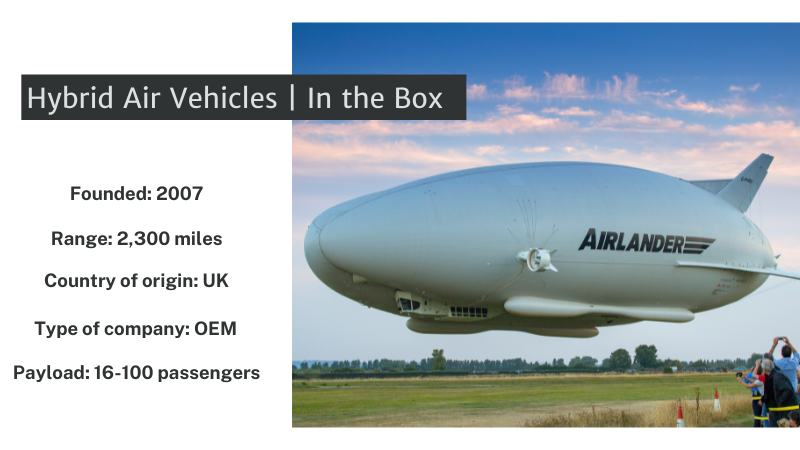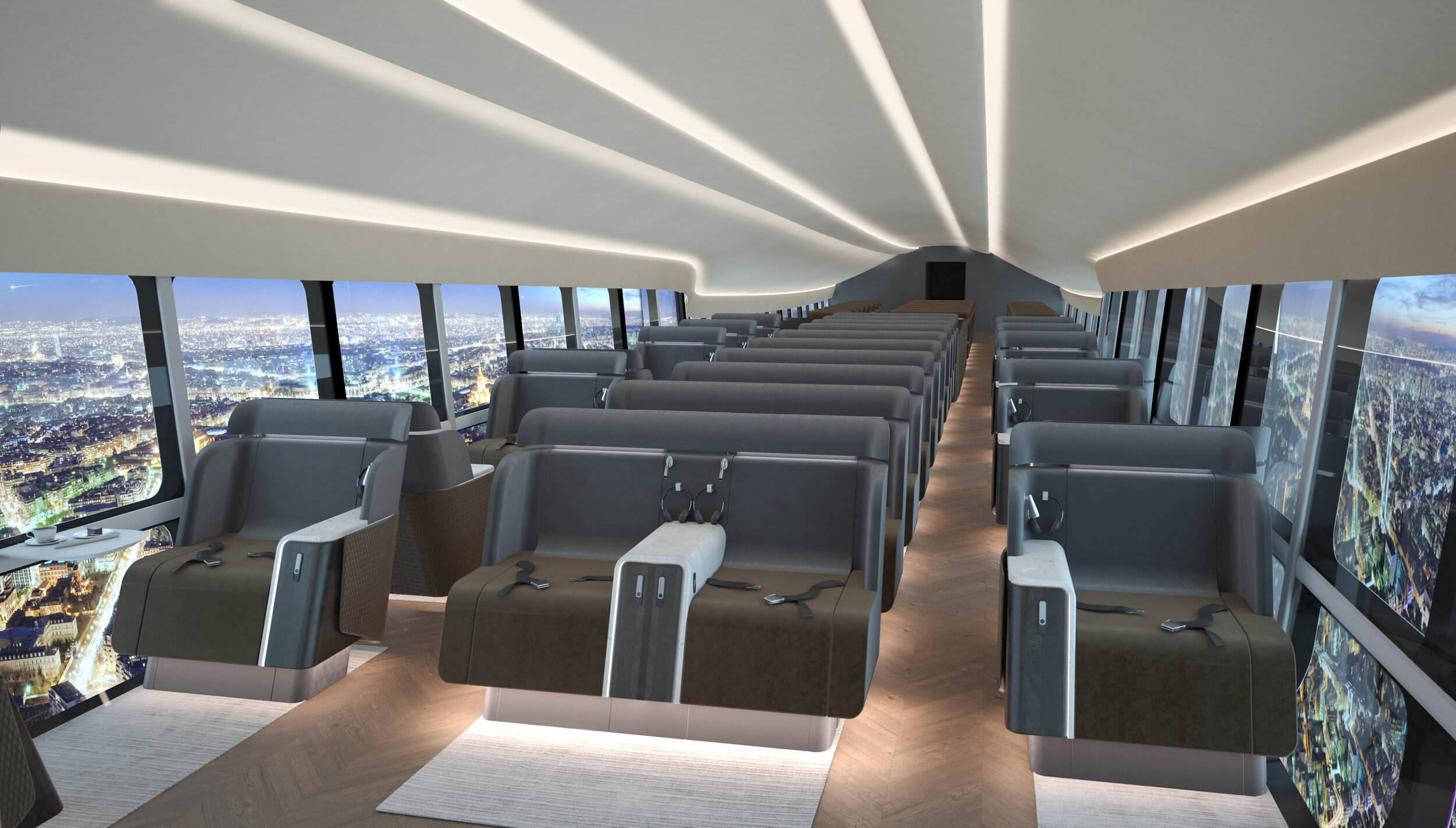Revolution.Aero Uplift: Hybrid Air Vehicles

exc-60c0907fe3d1e2124cebe73f
Hybrid Air Vehicles: ‘Lighter than air efficiency from a heavier than air platform’
Historically, airships have not had the best reputation. But in a sea of eVTOLs, and flying cars, UK-based Hybrid Air Vehicles (HAV) is aiming to sail forward by re-introducing its airship – Airlander 10 – for regional commercial travel. It is the world’s longest aircraft. The first passenger flight is scheduled for 2025.
The company’s latest aircraft has a fresh look and feel – with luxury interiors released recently – but really, it has been working on the concept for the more than a decade. The founders set the romantic idea of floating lighter than air into the practical framework of aviation.
The idea was devised in 2007, with the goal of launching a hybrid aircraft business because they felt that “this was the most efficient form of aircraft that could be used for everyday service”.
CEO Tom Grundy tells Revolution.Aero: “The underlying concept was to take near lighter than air efficiency but from a heavier than air platform.”
The project won its first contract with the US military from 2010-2013, which Grundy describes as the scale-up step. “And so, we carried the founders’ vision of bringing this practical new form of aviation to the world,” he adds. The first flight was completed in 2016, but the technology wasn’t perfect.
Grundy says operations have become smoother over the years, therefore driving costs of operation down as well. But HAV’s most unique selling point is its promise for much reduced carbon emissions. “With four kerosene engines, today’s technology and the prototype aeroplane burn 75% less CO2 emissions, compared with other aircraft of similar capacity,” said Grundy.
HAV also has an electric engine in development which will help achieve hybrid electric flight and cut 90% of CO2 emissions, in a 100-passenger aircraft, by the middle of the decade.
The target range for missions is under 220 miles (350kms). Although slower than conventional aircraft, passengers will arrive faster than they would by road. He said: “This is going to address domestic markets. You’re flying end-to-end journeys much faster than you can do it on the road, at a price that’s affordable and 10% of the carbon footprint of flying traditional aircraft.”
HAV’s Airlander 10 aims to carry up to 100 passengers on routes such as Liverpool to Belfast, Oslo to Stockholm and Seattle to Vancouver.
Passenger transport first
HAV forecasts “between 50-60% of the forward market for aircraft” to be logistics missions, but Grundy said it will be transporting passengers first.
“We see logistics as a market that is going to react to price and flexibility. And as we scale, our value proposition in those two dimensions just gets better.” Skylifter is an eVTOL air crane aiming to bring a solution to the construction industry.
HAV’s passenger-carrying missions are split between the experiential side – which will carry 16 passengers over three days – and regional air travel – carrying 100-passenger flights on routes such as Liverpool to Belfast. Other routes planned include Oslo to Stockholm, in six and a half hours; and Seattle to Vancouver in just over four hours.
This model “is designed to be an everyday, affordable travel experience”, said Grundy. The cost to fly passenger routes for customers is expected to be “between what we expect an airline price to be and what the current over land price is”.
The 16-passenger experience will be more expensive due to the number of people and time spent operating the aircraft.
A high-end luxury interior will be offered for the more exclusive, experiential travel routes.
Industry partners
HAV is partnering with companies that have a track record in operating aircraft fleets in the US – such as Vertex Aerospace – and in the UK – 2Excel Aviation. Collins Aerospace and University of Nottingham will be developing electric propulsion technologies.
Scott Loughran, commercial director, 2Excel Aviation, told Revolution.Aero: “There are many challenges to introducing a new type into service, especially one as innovative and novel as Airlander. However, as a team – OEM and operator – we are able to offer a really diverse range of options to any potential customer.”
2Excel has experience delivering VIP charter through its charter division and design organisation through its capability division. Loughran added: “As an air vehicle Airlander has some great attributes: plenty of cabin space, carrying capacity, power and persistence. HAV already have some exciting concepts developed to meet their customers aspirations.”
Grundy stressed the need for partnerships to bring the aircraft to market as planned. HAV’s regional commercial model is in line with what airlines are doing today. “We are having conversations with airlines about how to supplement or integrate with their networks.” However, he said the company would also look at connecting hubs to suburbs in the way urban air mobility hopes to.
HAV intends to offer trips over the North Pole with Arctic explorer Robert Swan. Other household names in the travel and hospitality sector are also interested, says Grundy.
Investor box
Private shareholders (Bruce Dickinson and Peter Hambro) and Department of Defense contract – $200m (£140m)
Looking for institutional funding now
CEO Grundy said funding up to date, around $200m (£140m), did not come from traditional funding rounds. This came from the contract from the US Department of Defense (DoD) and others in its private shareholder base. These include Peter Hambro, a founder of Russian gold-miner Petropavlovsk, and Iron Maiden frontman Bruce Dickinson.
HAV is currently looking for institutional funding – around the same scale – for the initial operations in the project.
The order book is open now and HAV is looking to grow its production facilities and launch its certification programme for the first three aircraft. It is attempting to certify the aircraft under ‘special condition’ with the UK’s CAA and parallelly with European Union Aviation Safety Agency (EASA), with the FAA certification to follow.
Grundy also confirmed the company would explore all-electric flights based on the range of its missions. “We’re finding some routes, even in the logistics base where all electric is feasible. But if you want the full range of utility that we think most customers are going to need, then hybrid looks like the best configuration for us at entry.”









